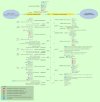Mechanisms of spinal cord injury regeneration in zebrafish: a systematic review
- PMID: 29238462
- PMCID: PMC5722987
- DOI: 10.22038/IJBMS.2017.9620
Mechanisms of spinal cord injury regeneration in zebrafish: a systematic review
Abstract
Objectives: To determine the molecular and cellular mechanisms of spinal cord regeneration in zebrafish.
Materials and methods: Medical databases of PubMed and Scopus were searched with following key words: Zebrafish; spinal cord injuries; regeneration; recovery of function. The map of mechanisms was performed using Xmind software.
Results: Wnt/ß-catenin signaling, L1.1, L1.2, Major vault protein (MVP), contactin-2 and High mobility group box1 (HMGB1) had positive promoting effects on axonal re-growth while Ptena had an inhibitory effect. Neurogenesis is stimulated by Wnt/ß-catenin signaling as well as HMGB1, but inhibited by Notch signaling. Glial cells proliferate in response to fibroblast growth factor (FGF) signaling and Lysophosphatidic acid (LPA). Furthermore, fgf signaling pathway causes glia bridge formation in favor of axonal regeneration. LPA and HMGB1 in acute phase stimulate inflammatory responses around injury and suppress regeneration. LPA also induces microglia activation and neuronal death in addition to glia cell proliferation, but prevents neurite sprouting.
Conclusion: This study provides a comprehensive review of the known molecules and mechanisms in the current literature involved in the spinal cord injury (SCI) regeneration in zebrafish, in a time course manner. A better understanding of the whole determining mechanisms for the SCI regeneration should be considered as a main goal for future studies.
Keywords: Regeneration recovery-of function; Spinal cord injuries; Spinal cord regeneration; Zebrafish.
Figures
Similar articles
-
Wnt/ß-catenin signaling is required for radial glial neurogenesis following spinal cord injury.Dev Biol. 2015 Jul 1;403(1):15-21. doi: 10.1016/j.ydbio.2015.03.025. Epub 2015 Apr 14. Dev Biol. 2015. PMID: 25888075 Free PMC article.
-
Wnt/β-catenin signaling promotes regeneration after adult zebrafish spinal cord injury.Biochem Biophys Res Commun. 2016 Sep 2;477(4):952-956. doi: 10.1016/j.bbrc.2016.07.006. Epub 2016 Jul 4. Biochem Biophys Res Commun. 2016. PMID: 27387232
-
Fgf-dependent glial cell bridges facilitate spinal cord regeneration in zebrafish.J Neurosci. 2012 May 30;32(22):7477-92. doi: 10.1523/JNEUROSCI.0758-12.2012. J Neurosci. 2012. PMID: 22649227 Free PMC article.
-
A growing field: The regulation of axonal regeneration by Wnt signaling.Neural Regen Res. 2018 Jan;13(1):43-52. doi: 10.4103/1673-5374.224359. Neural Regen Res. 2018. PMID: 29451203 Free PMC article. Review.
-
Biomaterial-supported MSC transplantation enhances cell-cell communication for spinal cord injury.Stem Cell Res Ther. 2021 Jan 7;12(1):36. doi: 10.1186/s13287-020-02090-y. Stem Cell Res Ther. 2021. PMID: 33413653 Free PMC article. Review.
Cited by
-
Zebrafish Astroglial Morphology in the Olfactory Bulb Is Altered With Repetitive Peripheral Damage.Front Neuroanat. 2020 Feb 11;14:4. doi: 10.3389/fnana.2020.00004. eCollection 2020. Front Neuroanat. 2020. PMID: 32116575 Free PMC article.
-
Effects of age on the response to spinal cord injury: optimizing the larval zebrafish model.Dev Biol. 2025 Oct;526:111-127. doi: 10.1016/j.ydbio.2025.07.003. Epub 2025 Jul 3. Dev Biol. 2025. PMID: 40617472 Free PMC article.
-
How Does the Central Nervous System for Posture and Locomotion Cope With Damage-Induced Neural Asymmetry?Front Syst Neurosci. 2022 Mar 3;16:828532. doi: 10.3389/fnsys.2022.828532. eCollection 2022. Front Syst Neurosci. 2022. PMID: 35308565 Free PMC article. Review.
-
Neurotrauma-From Injury to Repair: Clinical Perspectives, Cellular Mechanisms and Promoting Regeneration of the Injured Brain and Spinal Cord.Biomedicines. 2024 Mar 13;12(3):643. doi: 10.3390/biomedicines12030643. Biomedicines. 2024. PMID: 38540256 Free PMC article. Review.
-
Comprehensive therapeutics targeting the corticospinal tract following spinal cord injury.J Zhejiang Univ Sci B. 2019 Mar.;20(3):205-218. doi: 10.1631/jzus.B1800280. J Zhejiang Univ Sci B. 2019. PMID: 30829009 Free PMC article. Review.
References
-
- Pinto L, Gotz M. Radial glial cell heterogeneity-the source of diverse progeny in the CNS. Prog Neurobiol. 2007;83:2–23. - PubMed
-
- Rahimi-Movaghar V, Yazdi A, Karimi M, Mohammadi M, Firouzi M, Zanjani LO, et al. Effect of decompression on complete spinal cord injury in rats. International J Neurosci. 2008;118:1359–1373. - PubMed
-
- Rahimi-Movaghar V, Saadat S, Vaccaro AR, Ghodsi SM, Samadian M, Sheykhmozaffari A, et al. The efficacy of surgical decompression before 24 hours versus 24 to 72 hours in patients with spinal cord injury from T1 to L1–with specific consideration on ethics: a randomized controlled trial. Trials. 2009;10:77. - PMC - PubMed
-
- Rahimi-Movaghar V, Sayyah MK, Akbari H, Khorramirouz R, Rasouli MR, Moradi-Lakeh M, et al. Epidemiology of traumatic spinal cord injury in developing countries: a systematic review. Neuroepidemiology. 2013;41:65–85. - PubMed
Publication types
LinkOut - more resources
Full Text Sources
Miscellaneous


